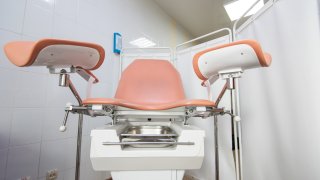In the wake of last week's oral arguments in Dobbs v. Jackson Women's Health Organization, the pending Supreme Court case that will determine the future of abortion access in America, there's a new spotlight on how women's reproductive health is treated in this country.
One physician went viral on Twitter over the weekend for questioning why sedation is the norm for colonoscopies but not IUD insertion. A tweet from a professor at Washington & Lee Law School racked up more than 52,000 likes for declaring that not wanting a baby is as good a reason to have an abortion or take birth control as surviving a rape or having endometriosis.
Abortion access in the U.S.
Who Is Scott Stewart, the Mississippi Lawyer Who Argued to Overturn Roe v. Wade?
Why Abortion Bans Will Hurt Low-Income Women and Women of Color More
Another physician, urogynecologist Dr. Ryan Stewart, has gone viral for asking women, trans and nonbinary people who need gynecological care how they'd redesign their gynecologist's office, if given the opportunity. Stewart is launching his own practice, Midwest Pelvis, in Indianapolis in early 2022.
Even if you've been going to a gynecologist for years and are pretty sure you've thought about all the ways the experience can be improved, the responses to Stewart's prompt are sure to blow you away.
Scales shouldn't be in public locations in the office
One Twitter user pointed out that patients don't want their weight taken in a place where someone might walk past and see the number. Another advised allowing patients to stand on the scale in a way so they don't see have to see their weight if they don't want to. Several others stressed the importance of only taking weight if necessary and allowing patients to opt out.
More diverse imagery around the office
Not seeing any images in your gynecologist's office that represent you and your life experience can make patients feel unwelcome. One Twitter user remarked that she's never seen pictures of Black women in any gynecologist's office she's visited.
A signal to let health professionals know you're done changing
Placing a switch in the patient room that, when the patient flips it, it turns on an external light or some sort of other signal to indicate the patient has changed and is ready for the doctor can cut down on waiting time and uncomfortable interruptions.
A changing room inside the exam room
A private area to change in the exam room again reduces the chance patients will be interrupted while changing and gives them somewhere to put their clothes. As the Twitter user behind the idea put it, "That little pile of clothing with undies that you have to place on a chair is demoralizing."
Warmers on the stirrups
The cold metal on your feet can add to the discomfort of the experience. One patient shared that her OB-GYN's office has stirrup covers with text joking about how awkward it is to get a pap smear, and that helps lighten the mood. Another suggestion was wood stirrups.
Adjustable thermostats in patient rooms
If you have to get naked, you should be able to control the temperature in the room. Only seems fair!
Buy equipment and gowns in the largest sizes
Patients come in a range of sizes, multiple Twitter users stressed.
A layout that prevents overhearing private health conversations
"No one should ever have to discuss any aspect of their care with anyone (I’m thinking nurse, receptionist) within earshot of other patients. Also, patients should not be able to listen to phone calls or dictation. You wouldn’t believe the things I’ve heard while sitting," one Twitter user explained.
Ceiling lifts for people who can't get on exam tables by themselves
This benefits both patients and the medical professionals responsible for helping lift patients, as the poster pointed out. She also recommended working with a design consultant who specializes in accessibility for people with a range of disabilities, not just physical.
Put away unnecessary instruments and models that can be triggering for patients
Gynecological care can be traumatic and incredibly painful. That's why one person said they tense up when they see anything that reminds them of their IUD insertion, which can make a regular exam that much harder.
Multiple waiting rooms
For patients struggling with infertility, waiting for extended periods next to new babies and expecting moms can be "excruciating," one person wrote. Another suggested waiting rooms for patients with kids and in their second or third trimester, and another for first trimester, infertility or non-OB needs.
Pay attention to the angle of exam beds
Definitely not ideal to spread your legs while not wearing underwear and while facing a door, when it feels like a stranger could walk through at any time.
Hopefully Stewart and plenty of other gynecologists are able to make use of these tips. Either way, thank you for asking!


